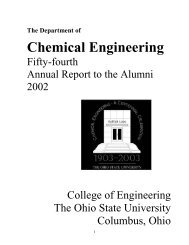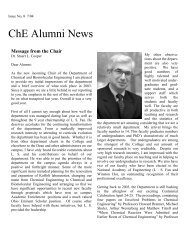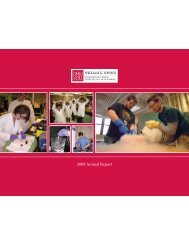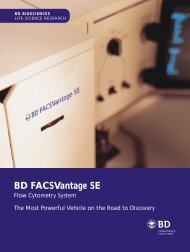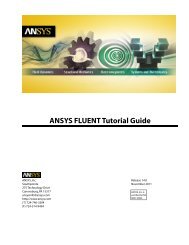2011 Alumni D - Chemical and Biomolecular Engineering ...
2011 Alumni D - Chemical and Biomolecular Engineering ...
2011 Alumni D - Chemical and Biomolecular Engineering ...
Create successful ePaper yourself
Turn your PDF publications into a flip-book with our unique Google optimized e-Paper software.
Jim Lee Develops New Gene Th erapy Method<br />
Helen C. Kurtz Professor Jim Lee <strong>and</strong> colleagues<br />
have developed a new method of gene<br />
therapy, which they have named Nanochannel<br />
Electroporation, also called NEP.<br />
Lee says that NEP allows them to investigate how<br />
drugs <strong>and</strong> other biomolecules aff ect cell biology<br />
<strong>and</strong> genetic pathways at a level not achievable<br />
by any other existing technique. Th is technique<br />
uses electricity to send bits of therapeutic<br />
biomolecules through a tiny channel <strong>and</strong> into a<br />
living cell in a fraction of a second, as opposed to<br />
using a needle.<br />
Currently, this process only works on one or several cells at a time, but they are<br />
developing a mechanical cell-loading system that would inject up to 100,000 cells at<br />
once, which could make clinical <strong>and</strong> diagnostics <strong>and</strong> treatments possible. Lee says<br />
that they hope NEP could become a tool for early cancer detection <strong>and</strong> treatment,<br />
specifi cally in leukemia <strong>and</strong> lung cancer. He is working with researchers at the Ohio<br />
State Comprehensive Cancer Center to explore these possibilities. With high cellloading,<br />
NEP has potential for effi cient <strong>and</strong> safe cell reprogramming which is critical<br />
for regenerative medicine.<br />
Bhavik Bakshi Co-Edits New Book<br />
Dr. Bhavik Bakshi, CBE Professor <strong>and</strong> Research Director of the<br />
Center for Resilience, is co-editor of the recently published<br />
book, Th ermodynamics <strong>and</strong> the Destruction of Resources. Th is<br />
book applies fundamental thermodynamics to problems of<br />
sustainability, energy, <strong>and</strong> resource use, <strong>and</strong> shows that some<br />
of the proposed sustainable solutions can be more destructive<br />
than the original problem. Both rigorous <strong>and</strong> readable, the book<br />
will be useful to a variety of educational <strong>and</strong> professional audiences interested in green<br />
engineering, industrial ecology, <strong>and</strong> sustainable manufacturing. Th e contributors are<br />
leading international fi gures from many disciplines, including engineers, ecologists,<br />
economists, physicists, chemists, <strong>and</strong> policy experts.<br />
Bakshi is a recognized international expert on process systems engineering <strong>and</strong><br />
sustainability science, <strong>and</strong> is the creator of Eco-LCA, an advanced soft ware tool for<br />
ecologically-based life cycle assessment.<br />
<strong>Chemical</strong> Looping Unit to Begin Construction<br />
Right: Syngas <strong>Chemical</strong><br />
Looping Subpilot Scale<br />
Unit at OSU West<br />
Campus<br />
Far Right: Syngas<br />
<strong>Chemical</strong> Looping Pilot<br />
Plant Design at the<br />
National Carbon<br />
Capture Center<br />
Sponsored by the Department of Energy’s<br />
Advanced Research Projects Agency-Energy <strong>and</strong><br />
Ohio Department of Development, Th e Ohio<br />
State University will lead an eff ort to scale-up the<br />
chemical looping technology to a 250-KW high<br />
pressure pilot plant at the Department of Energy’s<br />
National Carbon Capture Center in Wilsonville,<br />
Alabama.<br />
Partnering with Babcock & Wilcox Company,<br />
Particulate Solid Research, Inc., CONSOL<br />
Energy, Inc., Clear Skies Consulting LLC, <strong>and</strong> Air<br />
Products <strong>and</strong> <strong>Chemical</strong>, Inc., the pilot plant will<br />
begin construction this year. Th is demonstration will be the largest scale-up of the<br />
chemical looping gasifi cation technology for hydrogen <strong>and</strong> electricity cogeneration<br />
from coal <strong>and</strong> is directed by L.S. Fan (inventor of the process) along with his team<br />
consisting of Ohio State post-doctoral research associates <strong>and</strong> graduate students.<br />
<strong>Chemical</strong> looping dates back to the 1900’s with the steam iron process for hydrogen<br />
generation. Although simple in its concept, chemical looping has not been<br />
commercialized due to diffi culties such as looping particle performance <strong>and</strong> system<br />
design. Th e patented syngas chemical looping unit is unique because it can allow<br />
electricity <strong>and</strong>/or hydrogen production by using countercurrent moving bed reactor<br />
design <strong>and</strong> specially tailored oxygen carrier particles.<br />
-9-





